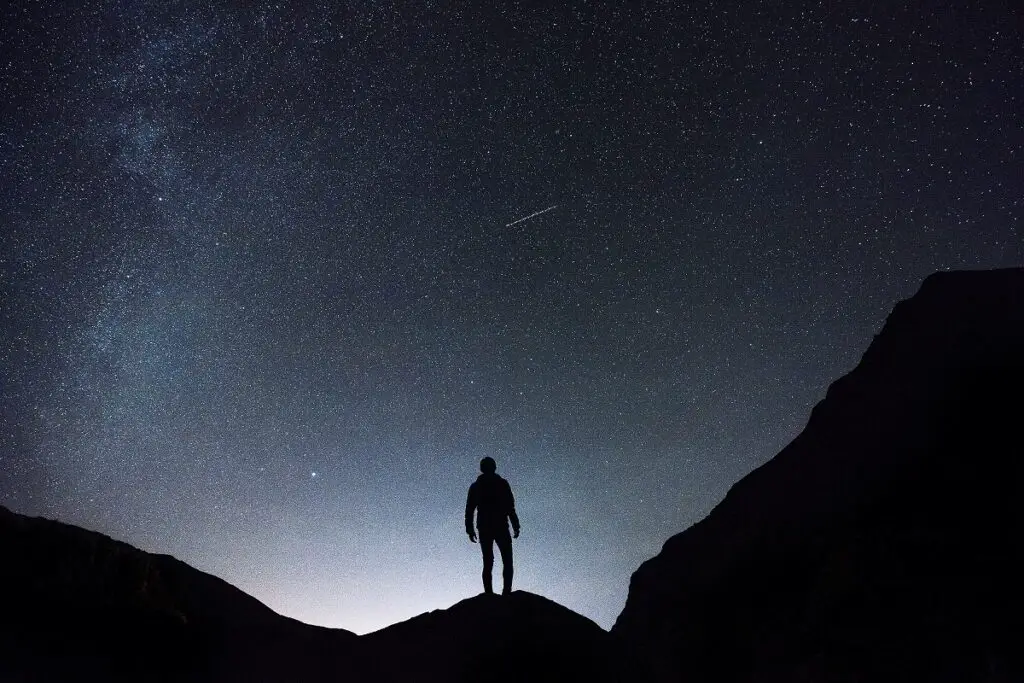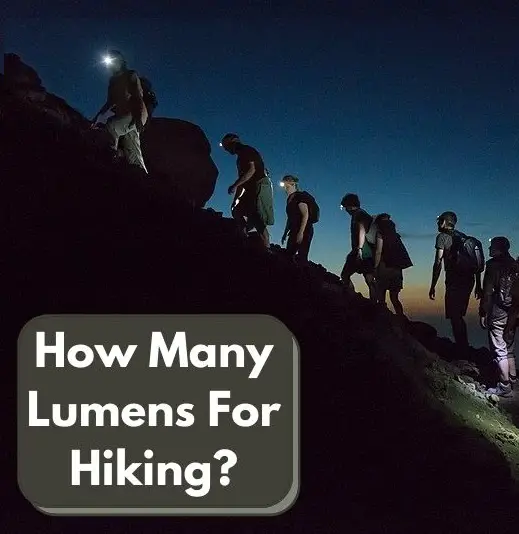Hiking is a great way to enjoy the outdoors while being active, and night hiking is an excellent option for adding some variety to your hikes. You need to have an adequate light source before you hit the trail at night- that starts with knowing how many lumens for hiking your flashlight or headlamp needs to be.
A flashlight or headlamp of 200 or more lumens is ideal for hiking at night in order to see far enough in front of you to remain safe.
Most hiking headlamp and flashlight manufacturers will clearly list the lumen output on the package or in the item specifications online – check the rating before making your selection.

What Is A Lumen?
A lumen is the measurement of the amount of light emitted by a light source such as a hiking flashlight or headlamp.
The higher the lumens, the brighter the light will be (with a fully charged battery).
You’ll find flashlights and hiking headlamps that run the full rage from 25-30 lumens on the lower end (very faint) up to 750 lumens (which is like a floodlight!).
We recommend light sources have at least 200 lumens for night hiking, but you can go higher based on your visibility preferences.
Other Features Besides Lumens For Hiking To Look For
Beam Distance
Lumens are important for how bright the light is, but just as important is how far the light goes.
Most beam distances (also called throw distances) are measured in feet or meters – think about how far ahead of you that you’ll need to see while night hiking.
A throw distance of 50 feet (15.24 meters) will suffice for most night hikers’ needs.
Beam Type
This is technically just adjusting the beam’s distance, but most hiking lights have fixed options (meaning they only provide a short or long beam distance, not both).
A short beam distance will act like a flood light and cast light very widely from the source, illuminating the trail all around you.
A long beam distance focuses the light into a narrower tube so it is concentrated further out from the light source.
When possible, opt for hiking headlamps or flashlights that have adjustable beam distances so you are always adequately prepared for different trail conditions.
Brightness Control
Sometimes you don’t need an enormous amount of light, whether that’s due to trail conditions or being courteous of others around you.
Some hiking flashlights and headlamps offer brightness control that may offer two or more levels of brightness for you to choose from.
We recommend picking a hiking headlamp with brightness control when possible.
Reactive Lighting
Some headlamps may offer reactive light technology, which allows them to adjust the brightness according to the ambient light (kind of like your smartphone screen’s ability to adjust it’s brightness based on the room you’re in).
Reactive lighting is better for long-term battery life and saves you the trouble of having to constantly adjust your light source.
Waterproof
This should be a no-brainer, but always choose waterproof hiking light options over non-waterproof ones.
You don’t want to get stuck in the rain and also have no light source while you’re hiking at night!
Look for headlamps and flashlights with a waterproof rating of IPX7 or greater.
Red Light/Night Vision Modes
Red light can be calmer than white light for low-intensity tasks and also won’t frighten certain animals so you can let them keep a low profile as you hike by.
Red light also won’t dampen your natural ability to see in the dark, so if you need to turn the light off for any reason there’s no adjustment period when compared to white light.
Battery Life & Rechargeable Options
Make sure you are aware of the battery life your hiking light provides, and be sure to pack extra batteries in your pack.
Rechargeable light sources are cheaper long-term because you don’t need to carry batteries – if anything, you can throw a lightweight power bank and USB cable in your hiking backpack that can juice up your smartphone and light source if needed.
Some light sources offer the ability to use both a rechargeable battery and external batteries, which is a great feature you should look for.
FAQs About How Many Lumens For Hiking & Hiking Lights
A hiking headlamp or hiking flashlight with at least 200 or more lumens is ideal for hiking at night in order to see far enough in front of you to remain safe.
The Fenix UC30 is our top choice and best value for hiking flashlights due to its 1000 lumen and 276 yard throw capabilities, battery or rechargeable operation, ultra-compact and IP68 waterproof design, and included holster.
We found the Vont Spark LED Headlamp to be the best value for hiking headlamps due to it’s waterproof construction, red light, 7 modes of operation, tilt features, lifetime warranty, and absurdly low pricing.
Headlamps are recommended as a better choice when hiking to keep your hands free for other items like trekking poles, and for the ability to move the light where you look or move your head.
Headlamps are just overall more convenient than flashlights, but you can absolutely use a flashlight for night hiking if you wish.
Wrapping Up Our Guide To How Many Lumens For Hiking
We hope we’ve shed some light (pun intended) on how many lumens you need for hiking at night.
Night hiking can be a little more dangerous than day hiking, so check out our guides to the best hiking knives for some other great gear options that you’ll need before hitting the trail after dark!

